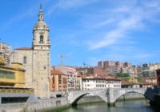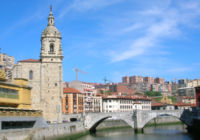
Bilbo Zarra
Encyclopedia
Bilbao La Vieja is the oldest neighbourhood of Bilbao
, being older than even the medieval urban district (Casco Viejo), founded in 1300. It lies right across the estuary
, on the left bank of the Nervion River, united to the old town by the bridge of San Anton pictured below (portrayed in the city's coat of arms). It is part of the 5th district of the city (Ibaiondo
).
 Its main economical activity are probably the taverns. Apart of Casco Viejo, Bilbao La Vieja also connects with the neighbourhood of San Francisco
Its main economical activity are probably the taverns. Apart of Casco Viejo, Bilbao La Vieja also connects with the neighbourhood of San Francisco
being a little more separated from Zabala, Abusu and the new development of Miribilla. Connected to Casco Viejo by the bridges of San Anton (portrayed in the Bilbao coat of arms), La Ribera and La Merced.
The development of the neighborhood was closely linked to that of the Miribilla mines, on the top of the Mirivilla mountain behind the old neighborhood. Recently redeveloped as a newly built neighborhood. Bilbao La Vieja was traditionally where the majority of the miners resided. It was some of the first land used as an expansion of the medieval city was undertaken in the 18th and 19th centuries and became a fashionable neighborhood by the end of the 19th century. By around that time prostitution became a big problem and that coupled with drug abuse condemned the area to neglect and marginalization, chiefly during the 1980s.
Today, under the municipal government's new initiatives the neighborhood is redeveloping, with a number of new businesses and subsidies aimed at urban renewal and attracting the young to the area. This initiative has largely been very fruitful thus far. Many new shops and young entrepreneurs are setting up shop.
The neighborhood is also home to a growing immigrant population and accordingly there are many Mediterranean, African and Latin American oriented stores and establishments, making it one os the most vibrant communities in Bilbao.
Bilbao
Bilbao ) is a Spanish municipality, capital of the province of Biscay, in the autonomous community of the Basque Country. With a population of 353,187 , it is the largest city of its autonomous community and the tenth largest in Spain...
, being older than even the medieval urban district (Casco Viejo), founded in 1300. It lies right across the estuary
Estuary of Bilbao
The Estuary of Bilbao lies at the common mouth of the rivers Nervion, Ibaizabal and Cadagua, that drain most of Biscay and part of Alava in the Basque Country, Spain. It is a large estuary long that extends from Bilbao to the Bilbao Abra bay, a widening that makes the final transition between...
, on the left bank of the Nervion River, united to the old town by the bridge of San Anton pictured below (portrayed in the city's coat of arms). It is part of the 5th district of the city (Ibaiondo
Ibaiondo
Ibaiondo is the 5th district of the city of Bilbao . Ibaiondo is a recently used name and in Basque language means Beside the river...
).

San Frantzisko
San Francisco is an important neighbourhood of Bilbao, in the Basque Country, and also one of the most degradated. In the last decades it has absorbed much of the immigration received by the city and has been integrated into the Ibaiondo district....
being a little more separated from Zabala, Abusu and the new development of Miribilla. Connected to Casco Viejo by the bridges of San Anton (portrayed in the Bilbao coat of arms), La Ribera and La Merced.
The development of the neighborhood was closely linked to that of the Miribilla mines, on the top of the Mirivilla mountain behind the old neighborhood. Recently redeveloped as a newly built neighborhood. Bilbao La Vieja was traditionally where the majority of the miners resided. It was some of the first land used as an expansion of the medieval city was undertaken in the 18th and 19th centuries and became a fashionable neighborhood by the end of the 19th century. By around that time prostitution became a big problem and that coupled with drug abuse condemned the area to neglect and marginalization, chiefly during the 1980s.
Today, under the municipal government's new initiatives the neighborhood is redeveloping, with a number of new businesses and subsidies aimed at urban renewal and attracting the young to the area. This initiative has largely been very fruitful thus far. Many new shops and young entrepreneurs are setting up shop.
The neighborhood is also home to a growing immigrant population and accordingly there are many Mediterranean, African and Latin American oriented stores and establishments, making it one os the most vibrant communities in Bilbao.

